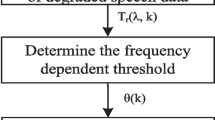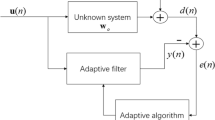Abstract
To efficiently reduce the impact of the trading-off between the convergence rate and the quality of identifying a system, and also to improve the robustness of the algorithm against unknown sparsity levels, a Modified Absolute Weighted Input using Log function (MAWILOG) for NLMS algorithm is proposed. The essence of the proposed algorithm is to assign, individually, each coefficient of the adaptive filter a variable stepsize that adapts according to a Log-term that takes advantage of the input power and the input signal underlying each filter coefficient, and adapts to the gradient value of each coefficient magnitude. Due to these attributes, the proposed approach outperforms the proportionate NLMS (PNLMS)-family regardless of sparsity level that is achieved by using the gradient of each coefficient individually to allocate large stepsize values for high gradient coefficients without directly inserting a sparse-aware constraint. Additionally, this technique is capable of overcoming the high computational complexity and high steady-state mean-square-deviation of the (PNLMS)-family. Simulation results of the proposed algorithm versus the comparable algorithms such as the NLMS, PNLMS, improved PNLMS, block-sparse PNLMS, and block-sparse IPNLMS are presented. Results have demonstrated that the proposed algorithm outperforms others in maintaining the lowest steady-state mean-square-deviation while attaining a fast convergence rate under various types of systems.

























Similar content being viewed by others
References
J. Benesty, S.L. Gay, An improved PNLMS algorithm, in IEEE International Conference on Acoustics, Speech, and Signal Processing (2002), pp. 1881–1884
J. Benesty, C. Paleologu, S. Ciochina, On regularization in adaptive filtering. IEEE/ACM Trans. Audio Speech Lang. Process. 19(6), 1734–1742 (2011)
J. Cui, P.A. Naylor, D.T. Brown, An improved IPNLMS algorithm for echo cancellation in packet-switched networks, in Proceedings IEEE International Conference on Acoustics, Speech, and Signal Processing (ICASSP), Montreal, Canada (2004), pp. 141–144
D.L. Duttweiler, Proportionate normalized least-mean squares adaptation in echo cancelers. IEEE/ACM Trans. Audio Speech Lang. Process. 8(5), 508–518 (2000)
H. Deng, M. Doroslovacki, Improving convergence of the PNLMS algorithm for sparse impulse response identification. IEEE Signal Process. Lett. 12(3), 181–184 (2005)
H. Deng, M. Doroslovacki, Proportionate adaptive algorithms for network echo cancellation. IEEE Trans. Signal Process. 54(5), 1794–1803 (2006)
F.D.C. De Souza, O.J. Tobias, R. Seara, Morgan DR (2010) A PNLMS algorithm with individual activation factors. IEEE Trans. Signal Process. 58(4), 2036–2047 (2010)
S. L. Gay, An efficient, fast converging adaptive filter for network echo cancellation, in Proceedings Thirty-Second Asilomar Conference Signals. Systems and Computers, Monterey, CA (1998), pp. 394–398
O. Gatera, H. Ilhan, A.H. Kayran, A novel LMS-BLM algorithm for AF relays based cooperative wireless networks. Int. J. Electron. Commun. 70(11), 1480–1488 (2016)
S. Haykin, Adaptive Filter Theory, 2nd edn. (Prentice-Hall, Englewood Cliffs, 1996).
S. Jiang, Y. Gu, Block-sparsity-induced adaptive filter for multi-clustering system identification. IEEE Trans. Signal Process. 63(20), 5318–5330 (2015)
B. Krstajic, L. Stankovic, Z. Uskokovic, Combined adaptive filter with LMS-Based algorithms. Int. J. Electron. Commun. 57(4), 295–299 (2003)
A. Khalili, A modified non-negative LMS algorithm for online system identification. Int. J. Electron. Commun. 95, 42–46 (2018)
P. Loganathan, A.W.H. Khong, P.A. Naylor, A sparseness controlled proportionate algorithm for acoustic echo cancellation, in 16th European Signal Processing Conference (EUSIPCO), Lausanne, Switzerland (2008), pp. 1–5
P. Loganathan, E.A.P. Habets, P.A. Naylor, A partitioned block proportionate adaptive algorithm for acoustic echo cancellation, in Proceedings of the Second APSIPA Annual Summit and Conference, Biopolis, Singapore (2010), pp. 371–376
J. Liu, S.L. Grant, Proportionate adaptive filtering for block-sparse system identification. IEEE/ACM Trans. Audio Speech Lang. Process. 24(4), 623–630 (2016)
Y. Li, Y. Wang, T. Jiang, Sparse-aware set-membership NLMS algorithms and their application for sparse channel estimation and echo cancelation. Int. J. Electron. Commun. 70(7), 895–902 (2016)
H.A. Mohamed-Kazim, I. Abdel-Qader, A framework for sparse adaptive system identification via integrating a new multiple time-varying stepsize and zero-attracting techniques, in IEEE 8th Annual Computing and Communication Workshop and Conference (CCWC) (2018), pp. 33–39
H.A. Mohamed-Kazim, I. Abdel-Qader, A new time adjusting step-size LMS technique for noise cancellation framework with mean square deviation analysis. WSEAS Trans. Syst. 17(30), 264–275 (2018)
H.A. Mohamed-Kazim, I. Abdel-Qader, A fast and robust system identification on compressive sensing signal recovery based on multiple time-vary step-size adaptation technique, in IEEE National Aerospace Electronics Conference (NAECON), Dayton, OH, USA (2019), pp. 379–383
H.A. Mohamed-Kazim, I. Abdel-Qader, A.M. Harb, A fast MPPT algorithm for smart grid-PV connected system based on multiple sparse-aware time-varying stepsize adaptation technique, in IEEE 10th International Renewable Energy Congress (IREC), Sousse, Tunisia (2019)
H.A. Mohamed-Kazim, I. Abdel-Qader, A.M. Harb, Efficient maximum power point tracking based on reweighted zero-attracting variable stepsize for grid interfaced photovoltaic systems. Elsevier J. Comput. Electr. Eng. (CAEE), 85(106672) (2020)
S.J. Park, C.G. Cho, C. Lee, D.H. Youn, S.H. Park, Integrated echo and noise canceler for hands-free applications. IEEE Trans. Circuits Syst. II Analog Digit. Signal Process. 49(3), 188–195 (2002)
O. Taheri, S.A. Vorobyov, Reweighted l1-norm penalized LMS for sparse channel estimation and its analysis. Signal Process. 104, 70–79 (2014)
T.V. Waterschoot, G. Rombouts, P. Verhoeve, M. Moonen, Doubletalk-robust prediction error identification algorithms for acoustic echo cancellation. IEEE Trans. Signal Process. 55(3), 846–858 (2007)
Y.H. YuZhao, Proportionate NSAF algorithms with sparseness-measured for acoustic echo cancellation. Int. J. Electron. Commun. 75, 53–62 (2017)
Z. Zecevic, B. Krstajic, M. Radulovic, A new adaptive algorithm for improving the ANC system performance. Int. J. Electron. Commun. 69(1), 442–448 (2015)
W. Zeng, H. Li, X. Zhu, C. Chen, A 2D adaptive beamforming method in sparse array. Int. J. Electron. Commun. 77, 100–104 (2017)
Acknowledgements
The authors would like to thank the editors and reviewers for their valuable comments and suggestions, which have helped to improve the quality of this work.
Author information
Authors and Affiliations
Corresponding author
Ethics declarations
Conflict of interest
The authors declare that they have no conflict of interest.
Availability of Data and Material
All data generated or analyzed during this study are included in this published article.
Additional information
Publisher's Note
Springer Nature remains neutral with regard to jurisdictional claims in published maps and institutional affiliations.
Rights and permissions
About this article
Cite this article
Mohamed-Kazim, H.A., Abdel-Qader, I. Coefficient-Gradient-Based Individualized Stepsize Adaptation Mechanism for Robust System Identification. Circuits Syst Signal Process 40, 3033–3074 (2021). https://doi.org/10.1007/s00034-020-01612-6
Received:
Revised:
Accepted:
Published:
Issue Date:
DOI: https://doi.org/10.1007/s00034-020-01612-6




